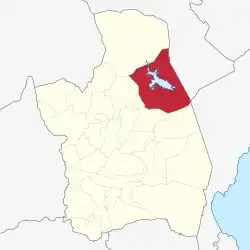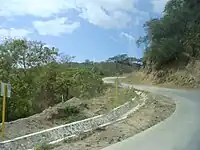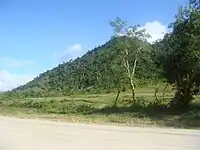Pantabangan | |
|---|---|
| Municipality of Pantabangan | |
 Mountains in Pantabangan | |
 Flag  Seal | |
 Map of Nueva Ecija with Pantabangan highlighted | |
OpenStreetMap | |
.svg.png.webp) Pantabangan Location within the Philippines | |
| Coordinates: 15°48′31″N 121°08′36″E / 15.8086°N 121.1433°E | |
| Country | Philippines |
| Region | Central Luzon |
| Province | Nueva Ecija |
| District | 2nd district |
| Founded | 1701 |
| Barangays | 14 (see Barangays) |
| Government | |
| • Type | Sangguniang Bayan |
| • Mayor | Roberto T. Agdipa |
| • Vice Mayor | Monaliza H. Agdipa |
| • Representative | Micaela S. Violago |
| • Municipal Council | Members |
| • Electorate | 27,784 voters (2022) |
| Area | |
| • Total | 392.56 km2 (151.57 sq mi) |
| Elevation | 260 m (850 ft) |
| Highest elevation | 547 m (1,795 ft) |
| Lowest elevation | 107 m (351 ft) |
| Population (2020 census)[3] | |
| • Total | 31,763 |
| • Density | 81/km2 (210/sq mi) |
| • Households | 7,213 |
| Economy | |
| • Income class | 1st municipal income class |
| • Poverty incidence | 16.01 |
| • Revenue | ₱ 283.1 million (2020) |
| • Assets | ₱ 1,486 million (2020) |
| • Expenditure | ₱ 253.4 million (2020) |
| • Liabilities | ₱ 516.6 million (2020) |
| Service provider | |
| • Electricity | Pantabangan Municipal Electric System (PAMES) |
| Time zone | UTC+8 (PST) |
| ZIP code | 3124 |
| PSGC | |
| IDD : area code | +63 (0)44 |
| Native languages | Ilocano Tagalog |
Pantabangan, officially the Municipality of Pantabangan, is a 1st class municipality in the province of Nueva Ecija, Philippines. According to the 2020 census, it has a population of 31,763 people.[3]
This is the site of the Pantabangan Dam and Lake.
Located in the northern part of Nueva Ecija, Pantabangan is located at the foot of Mt. Mabilog below Mt. Dalimanok which are found between Sierra Madre and Caraballo Mountain ranges. It is home to the Pantabangan–Carranglan Watershed Forest Reserve.
Pantabangan is 51 kilometres (32 mi) from Cabanatuan, 65 kilometres (40 mi) from Palayan, and 167 kilometres (104 mi) from Manila.
History
The place was discovered on November 30, 1645, by Fr. Juan Alonzo de Abarca, an Augustinian priest who with the 29th Spanish mission in the Philippines.
The village grew into a settlement and was officially included in the map of the Philippines in 1747. In 1900, Pantabangan formally became a town.
In early 16th to 17th centuries, the “Id-dules” (Aetas or Baluga) and Egongots (Ilongots) tribe inhabited the southern Sierra Madre and Caraballo Mountains. Pantabangan (Pantabanganan in early 18th century) may have came from the root Ilongot word "Sabangan or Sabanganan" that means "junction of water streams". It was learned that most of the places in Central Luzon were derived from Ilongot word like Caanaoan, Puncan, Cadanglaan (now Carranglan), Kabaritan (Now San Jose City) and others. Bungamong (Bongabon) and Cadanglaan was formerly sitio of Pantabangan and Kabaritan also part of Pantabangan.
When the Second World War broke out, Japanese Imperial forces occupied the town municipality of Pantabangan in 1942 under the Japanese Occupation. During the Liberation, combined military forces of the Filipino troops under the Philippine Commonwealth Army and Philippine Constabulary units and the American troops of the United States Army and the U.S. Army Air Forces came, invaded and recaptured the town of Pantabangan and defeated Japanese soldiers in the Battle of Pantabangan and ended World War II.
In 1950, Sitio Lublub was converted into a barrio in the municipality, separated from Barrio Marikit. Lublub became part of the municipality of Alfonso Castañeda in Nueva Vizcaya upon the latter's creation in 1979.[5]
In May 1966, the Old Philippine Congress passed the Upper Pampanga River Project Act (Republic Act 5499) authorizing the construction of the Pantabangan Dam and its appurtenant structures. The groundbreaking ceremony led by then President Ferdinand E. Marcos took place on June 11, 1971. The project was finally completed in August 1974.
The construction of the Dam had great economic and social impact on the lives of Pantabangeños. About 8,100 hectares (20,000 acres) of productive farmland and the town center (East and West Poblacion) along with seven outlying barangays (Villarica, Liberty, Cadaclan, San Juan, Napon-Napon, Marikit and Conversion) were submerged under the new lake. Residents were relocated to higher ground overlooking the vast reservoir, which became the new Pantabangan town center. Before the expansion of the dam through the Casecnan Project in the 1990s, the belfry of the 18th century church resurfaced from the dam's summer low water level. During drought in 1983, some areas of the old town emerged.[6]
The Pantabangan Dam is claimed to be the second largest dam in Asia, and supplies the irrigation requirements for about 77,000 hectares (190,000 acres) of agricultural lands in Central Luzon. Its power station generates 112 megawatts of hydroelectric power.
In February 1996, then President Fidel V. Ramos led the ground-breaking ceremony of the Casecnan Transbasin Project, a 27 kilometres (17 mi) tunnel from the Casecnan River in Nueva Viscaya to a terminal point at the Pantabangan reservoir and was commissioned on December 11, 2001. The project aims to augment the capacity of the dam to irrigate an additional 50,000 hectares (120,000 acres) of agricultural land and generate an additional 140 megawatts of hydroelectric power for the Luzon grid.
The present Pantabangan town has 14 barangays and a total land area of about 41,735 hectares. The succeeding years since its relocation saw its progress from a fifth-class municipality in 1975, then to a fourth-class, then to a second class Municipality in 2006 and finally, in July 2008, pursuant to Section 2 of the Department of Finance Order No. 23-08, Pantabangan was reclassified as First-Class Municipality. It is the only town in the Philippines which boasts of three hydroelectric plants within its territorial jurisdiction.
Geography
Barangays
Pantabangan is politically subdivided into 14 barangays. Each barangay consists of puroks and some have sitios.
- Cadaclan
- Cambitala
- Conversion
- Ganduz
- Liberty
- Malbang
- Marikit
- Napon-Napon
- Poblacion East
- Poblacion West
- Sampaloc
- San Juan
- Villarica
- Fatima
Climate
| Climate data for Pantabangan, Nueva Ecija | |||||||||||||
|---|---|---|---|---|---|---|---|---|---|---|---|---|---|
| Month | Jan | Feb | Mar | Apr | May | Jun | Jul | Aug | Sep | Oct | Nov | Dec | Year |
| Mean daily maximum °C (°F) | 28 (82) |
29 (84) |
30 (86) |
32 (90) |
31 (88) |
30 (86) |
29 (84) |
28 (82) |
28 (82) |
28 (82) |
29 (84) |
28 (82) |
29 (84) |
| Mean daily minimum °C (°F) | 18 (64) |
18 (64) |
19 (66) |
20 (68) |
22 (72) |
22 (72) |
22 (72) |
22 (72) |
22 (72) |
22 (72) |
20 (68) |
18 (64) |
20 (69) |
| Average precipitation mm (inches) | 4 (0.2) |
6 (0.2) |
7 (0.3) |
12 (0.5) |
61 (2.4) |
89 (3.5) |
96 (3.8) |
99 (3.9) |
81 (3.2) |
88 (3.5) |
37 (1.5) |
13 (0.5) |
593 (23.5) |
| Average rainy days | 2.5 | 3.0 | 4.1 | 6.3 | 15.8 | 19.4 | 22.5 | 21.6 | 20.1 | 17.5 | 9.6 | 4.0 | 146.4 |
| Source: Meteoblue[7] | |||||||||||||
Demographics
|
| |||||||||||||||||||||||||||||||||||||||||||||||||||
| Source: Philippine Statistics Authority[8][9][10][11] | ||||||||||||||||||||||||||||||||||||||||||||||||||||

Languages
Tagalog is predominantly spoken in Pantabangan followed by Ilocano dialect. People of Pantabangan "Pantabangenian" are also known for their very distinct strong Pantabangan accent, called "Adyu-ari".
Economy
Arts and Culture
The Pandawan Festival made its debut in April 2008, showcasing many local talents as well as other entertainments including Indigenouism art activities like art workshop and rural development thru art awareness programs. It features cooking contests, dance competitions and street dancing, and a parade.[19]
Gallery
 Pantabangan Dam
Pantabangan Dam Forests and mountains (Cadaclan)
Forests and mountains (Cadaclan) Pantabangan N.E. Transport and Public Market (East Poblacion)
Pantabangan N.E. Transport and Public Market (East Poblacion) Hills and forests (Marikit)
Hills and forests (Marikit)
Notable personalities
- Jason Abalos, a Filipino actor.
References
- ↑ Municipality of Pantabangan | (DILG)
- ↑ "2015 Census of Population, Report No. 3 – Population, Land Area, and Population Density" (PDF). Philippine Statistics Authority. Quezon City, Philippines. August 2016. ISSN 0117-1453. Archived (PDF) from the original on May 25, 2021. Retrieved July 16, 2021.
- 1 2 Census of Population (2020). "Region III (Central Luzon)". Total Population by Province, City, Municipality and Barangay. Philippine Statistics Authority. Retrieved 8 July 2021.
- ↑ "PSA Releases the 2018 Municipal and City Level Poverty Estimates". Philippine Statistics Authority. 15 December 2021. Retrieved 22 January 2022.
- ↑ "Alfonso Castañeda". Province of Nueva Vizcaya. Government of the Philippines. Retrieved May 6, 2023.
- ↑ "An old submerged town reappears during a drought in the Philippines". Republic of the Philippines. Local Government of Pantabangan. Retrieved 5 June 2022.
- ↑ "Pantabangan: Average Temperatures and Rainfall". Meteoblue. Retrieved 4 May 2020.
- ↑ Census of Population (2015). "Region III (Central Luzon)". Total Population by Province, City, Municipality and Barangay. Philippine Statistics Authority. Retrieved 20 June 2016.
- ↑ Census of Population and Housing (2010). "Region III (Central Luzon)" (PDF). Total Population by Province, City, Municipality and Barangay. National Statistics Office. Retrieved 29 June 2016.
- ↑ Censuses of Population (1903–2007). "Region III (Central Luzon)". Table 1. Population Enumerated in Various Censuses by Province/Highly Urbanized City: 1903 to 2007. National Statistics Office.
{{cite encyclopedia}}: CS1 maint: numeric names: authors list (link) - ↑ "Province of Nueva Ecija". Municipality Population Data. Local Water Utilities Administration Research Division. Retrieved 17 December 2016.
- ↑ "Poverty incidence (PI):". Philippine Statistics Authority. Retrieved December 28, 2020.
- ↑ "Estimation of Local Poverty in the Philippines" (PDF). Philippine Statistics Authority. 29 November 2005.
- ↑ "2003 City and Municipal Level Poverty Estimates" (PDF). Philippine Statistics Authority. 23 March 2009.
- ↑ "City and Municipal Level Poverty Estimates; 2006 and 2009" (PDF). Philippine Statistics Authority. 3 August 2012.
- ↑ "2012 Municipal and City Level Poverty Estimates" (PDF). Philippine Statistics Authority. 31 May 2016.
- ↑ "Municipal and City Level Small Area Poverty Estimates; 2009, 2012 and 2015". Philippine Statistics Authority. 10 July 2019.
- ↑ "PSA Releases the 2018 Municipal and City Level Poverty Estimates". Philippine Statistics Authority. 15 December 2021. Retrieved 22 January 2022.
- ↑ Caparas, Celso de Guzman (13 May 2019). "8th Pandawan Festival in Pantabangan, Nueva Ecija". Philippine Star Global.